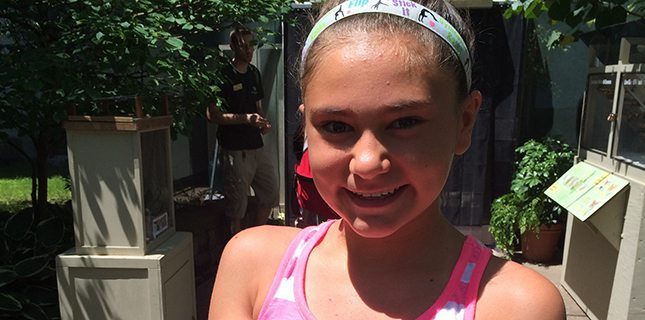SCIG Helps Olivia Thrive at Home, And In The Gym

 Olivia is your typical middle school student. She loves gymnastics – her favorite events are beams and bars – and her favorite subject in school is Language Arts. She is the middle sister of three, and has a cat, Lilo.
Olivia is your typical middle school student. She loves gymnastics – her favorite events are beams and bars – and her favorite subject in school is Language Arts. She is the middle sister of three, and has a cat, Lilo.
But Olivia does something twice a week that makes her pretty extraordinary – she administers her own subcutaneous immunoglobulin (SCIG).
“Within the last year, she has really taken charge of her medical cares, and now helps draw up her SCIG and does the infusions herself – with my watchful eye close by,” comments Rachel, Olivia’s mom. “I think this is one of her greatest accomplishments. If you ask Olivia what her greatest accomplishment is, she would tell you making the team at gymnastics.”
Finding Answers for Concerns
 Diagnosed with primary immune deficiency at three, Olivia had a port and g-tube placed at the age of four to combat her failure to thrive that stemmed from her body’s energy going towards fighting multiple infections rather than proper growth.
Diagnosed with primary immune deficiency at three, Olivia had a port and g-tube placed at the age of four to combat her failure to thrive that stemmed from her body’s energy going towards fighting multiple infections rather than proper growth.
“She kept getting sick all the time and they weren’t major infections, but they were chronic,” remembers Rachel. “She had a sinus surgery done, and they went in and cultured what was in there, and they found a garden variety of organisms. And so that’s when they decided to dig in deeper and decide what was going on, which is when she was diagnosed with immune deficiency.”
The Best Type of Therapy
 To improve her immune system, Olivia began receiving intravenous immunoglobulin (IVIG) therapy at the hospital when she was diagnosed with immune deficiency, but experienced issues with how her body tolerated it during infusions – often requiring she received fluids before and after to combat symptoms such as headaches and nausea.
To improve her immune system, Olivia began receiving intravenous immunoglobulin (IVIG) therapy at the hospital when she was diagnosed with immune deficiency, but experienced issues with how her body tolerated it during infusions – often requiring she received fluids before and after to combat symptoms such as headaches and nausea.
PHS infusion nurses recognized that SCIG might be a better method to receive immunoglobulin, so eventually Olivia switched and together with her family, discovered what works best for her – infusions through four sites, twice a week.
“Being able to do SCIG at home has been the best decision we have made,” shares Rachel. “When she first started getting IVIG at the hospital we would be there for hours. Now, we are able to do infusions on our own time, which means Olivia doesn’t miss school or gymnastics and we can spend time together as a family.”
Addressing Additional Symptoms
In 2010, with the immunity deficiency concerns straightened out, Olivia and her family began addressing underlying symptoms she had including blood sugar and gastric motility issues, along with headaches and additional concerns.
“We were sent to see a neurologist and after the second visit, the doctor wanted her tested for a mitochondrial disorder. So we went to Atlanta and had the muscle biopsy in 2010, and in January 2011, we got the official diagnosis that she has a type of mitochondrial disorder.”
Looking Ahead
 After seven and a half years with her port and g-tube, Olivia was weaned off her feeding tube and had both removed this past October. Looking back, Rachel sees how much Olivia’s medical needs have evolved from needing a lot of care and medications to slowly reducing the medications and finding solutions to her motility issue.
After seven and a half years with her port and g-tube, Olivia was weaned off her feeding tube and had both removed this past October. Looking back, Rachel sees how much Olivia’s medical needs have evolved from needing a lot of care and medications to slowly reducing the medications and finding solutions to her motility issue.
Right now, Olivia is looking forward to a family trip to Florida in August and starting 7th grade this fall (and gymnastics, of course). And as for her future? She wants to be a doctor or a nurse in the hospital so she can help kids, just like she’s seen so many do for her.
Originally published: July 25, 2014

